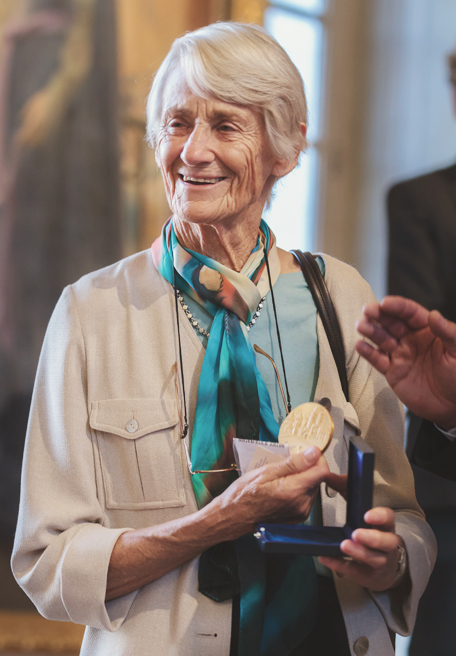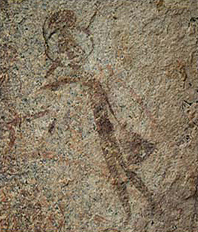 |
 |
Forward by Dr. Meave Leakey |
I have often wished over the years that the Tanzania rock paintings might be better known and more widely appreciated. They are so beautiful and disappearing so fast. (Mary D. Leakey 1983).
Many people believe that prehistoric rock art is restricted to the Palaeolithic paintings in the European caves of France and Spain.
Few appreciate that Africa has an equally impressive record, and that some of the most beautiful paintings are to be found in Tanzania. The majority of the Tanzanian rock paintings are found in Kondoa and the contiguous Lake Eyasi basin. Those at Kondoa are the most easily accessible and perhaps the most dramatic because they are frequently painted on impressive rock faces, situated on steep rocky slopes overlooking valleys below. These paintings were also the first to be reported, as long ago as 1908.
Surprisingly they were given little attention, being described and recorded only in brief publications by various scholars until Mary Leakey published her beautifully illustrated book describing the art of Kondoa-Irangi. The renewed research efforts described in the following pages extend this record, and illustrate how rich this heritage really is; in five field seasons, Dr. Fidelis Masao and his colleagues recorded 140 new sites in Singida and 35 in the Lake Eyasi basin. This book thus represents a significant contribution in promoting public awareness of this priceless Tanzanian heritage.
Human figure from Ngwaginki
(Kitaturu), Singida Region
My interest in the Tanzanian rock art began in 1978 when I came across tracings of the Kondoa rock paintings that Louis and Mary Leakey made in a three month field season in 1951, lying forgotten in the Kenya National Museum’s archaeology laboratory. After completing their field documentation, Louis and Mary unsuccessfully approached a number of potential publishers, and on failing to find a publisher they eventually gave up. After I came across the paintings in 1978, renewed efforts by Richard Leakey led to the publication of Mary’s Africa’s Vanishing Art.
I was fortunate to have the privilege of working with Mary for several most enjoyable weeks on the preparation of this ground breaking book. As we studied each painting in detail prior to writing descriptions, I came to appreciate fully the beauty and simplicity of the art. A few very simple lines clearly define the essential characters of the animals painted, cleverly depicting their characteristic behaviour and movements. Later I was able to visit Kondoa with Mary and see the original paintings on the huge granite outcrops set in beautiful Brachystegia woodland.
Sadly, many of the paintings that Mary and Louis recorded in the early ‘50s are now severely deteriorated, or in some cases completely destroyed. Conservation measures are urgently required to prevent the loss of additional paintings. But even as long ago as 1935, when Mary Leakey first saw the Kondoa paintings and the majority were in a relatively good state of preservation, Mary recognised the deteriorating condition of some of them and their conservation was one of her greatest concerns. Fortunately, in recent years a number of foundations have been formed specifically to raise awareness and conservation funds for Africa’s rock art. These foundations are largely regionally based, and mostly in southern Africa, but in 1996 TARA, the Trust for African Rock Art, was founded to protect the rock art of Africa. TARA recognises that Africa’s art is a world heritage. It is thus dedicated to create a greater global awareness of the importance and endangered state of Africa’s rock art; to survey and monitor sites, to be an information source and to promote and support rock art conservation measures. Mary Leakey described the rock art of Africa as “the richest variety of rock art anywhere on earth”. These increasing conservation efforts give hope for the future.
Before meaningful conservation measures can be put in place, it is essential to have good records of the sites and their state of preservation. Dr. Masao’s fieldwork has gone far in improving this record; many new sites, previously undocumented are described here, and in some cases these were unknown even to the local people. Although there remains much to be done, this work is timely, not only in promoting awareness of the Tanzanian rock art, but also in providing stimulus to the authorities to take action in introducing effective conservation measures. If this does not happen, in a few decades much of this unique heritage will be lost forever. Tanzania is internationally recognised for its prehistory; the fossil remains of human ancestors excavated at the Olduvai Gorge, the long footprint trail at Laetoli, and the exceptional dinosaur record at Tendaguru and other sites. The rock art of Central Tanzania is an important part of this heritage. It must not be allowed to vanish.
Meave LeakeyDecember 2003
→
Rock Art in Tanzania
→
Tanzania Rock Art - Forward by Dr. Meave Leakey
→
Overview of Tanzania Rock Art Sites
→
Tanzania Conservation & Management
→
Tanzania Rock Art Sites|
1-2 |
3-6 |
7-9 |
10-12 |
13-14 |
15-16 |
17-18 |
19-21 |
22-24 |
25-26 |
→
Africa Rock Art Archive
→
Bradshaw Foundation
Like us on Facebook & Follow us on Twitter to receive news & updates:









